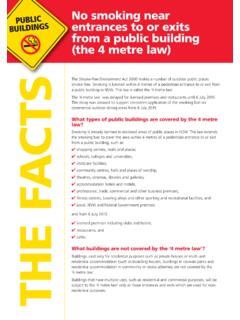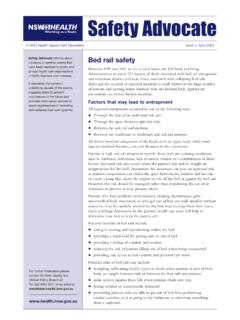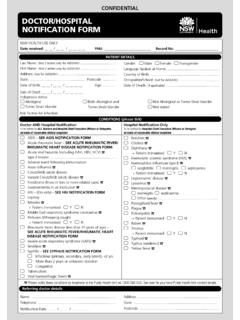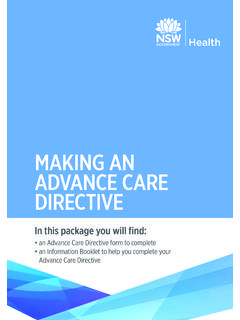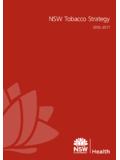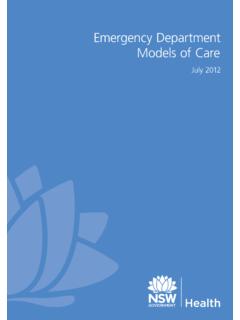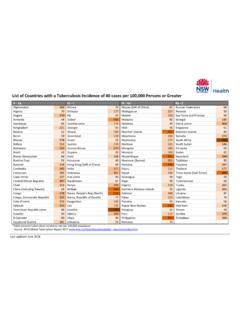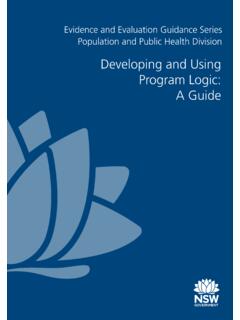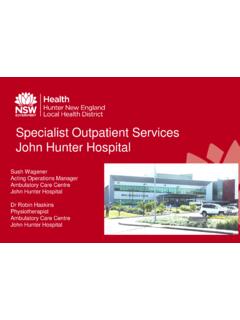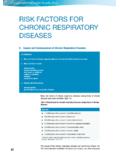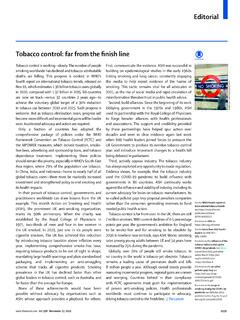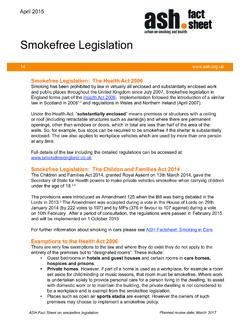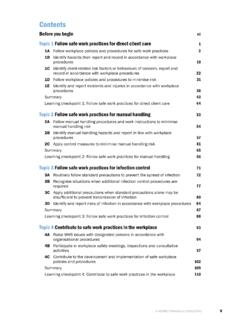Transcription of Report Seclusion Restraint Observation - Ministry of Health
1 Review of Seclusion , Restraint and Observation of consumers with a mental illness in NSW Health facilitiesDecember 201 7Ms Elizabeth KoffSecretaryNSW Ministry of Health73 Miller StNORTH SYDNEY NSW 2060 Dear Ms KoffPlease find enclosed the final Report of the Review of Seclusion , Restraint and Observation of consumers with a mental illness in NSW Health Report is informed by an evidence base from local and international experience, a self-audit of practice, 10 community consultations, consultations with more than 300 frontline mental Health and emergency department staff and more than 300 mental Health and emergency department leaders, site visits to 25 facilities and more than 100 written submissions.
2 I would particularly like to express my gratitude to the many consumers, carers and their families who have shared their experiences so that we may improve our systems of care. Reducing and, where possible, eliminating the use of Seclusion and Restraint will not happen overnight. As a review team, we are confident that if NSW Health implements our recommendations, they will be well on their way to achieving would like to take this opportunity to express my sincere thanks to my fellow review team members, the late Commissioner Jackie Crowe, Dr Kevin Huckshorn, Ms Karen Lenihan, Ms Julie Mooney and Dr Robyn Shields. Their commitment to this review has been would also like to thank Mr Andrew McAlister, Ms Joanne Sharpe and Dr Titia Sprague for their support throughout the sincerely Dr Murray WrightNSW Chief Psychiatrist8 December 20174 The Review of Seclusion , Restraint and Observation of Consumers with a Mental Illness in NSW Health Facilities This Report is dedicated to the memory of two very important women who never met, but without whom this review and Report would not have occurred.
3 Miriam Merten, whose mistreatment and death shocked us all, and was the catalyst for establishing this review, and Jackie Crowe, a vital member of the review team who brought energy, compassion, integrity and courage to the review Review of Seclusion , Restraint and Observation of Consumers with a Mental Illness in NSW Health Facilities Contents Introduction .. 6 Recommendations .. 7 Background .. 9 Legislative context .. 10 Policy context .. 10 Dangers of Seclusion and Restraint .. 11 Evidence-based approaches .. 12 Data collection, reporting and performance framework .. 14 Patient safety .. 17 The review .. 18 Discussion and findings .. 22 Culture and leadership.
4 23 Patient safety .. 27 Accountability and governance .. 28 Workforce .. 32 Consumer and carer participation .. 35 Data .. 37 The built and therapeutic environment .. 38 Recommendations .. 42 References .. 44 Glossary and abbreviations .. 506 The Review of Seclusion , Restraint and Observation of Consumers with a Mental Illness in NSW Health Facilities The Review of Seclusion , Restraint and Observation of consumers with a mental illness in NSW Health facilities has been an important opportunity to analyse the use of restrictive practices, compare New South Wales with national and international standards, and to hear from consumers, carers and other stakeholders.
5 The review was announced following the release of distressing closed circuit television (CCTV) footage of Ms Miriam Merten in Seclusion showing events which contributed to her death. Public and professional outrage spurred this review of current practice to make recommendations to reduce, and where possible eliminate, the use of Seclusion and Restraint in NSW. In aiming to prevent harm and promote safer services for consumers and staff, the review team has also considered the broader strategies for clinical governance, safety and quality within the services reviewed. The use of Seclusion and Restraint in modern Health settings is a key focus, given the well documented traumatic and damaging impact of these practices.
6 In NSW, there were nearly 3700 episodes of Seclusion in 2016 17. In this same period, 2200 people were secluded and on average they spent five and a half hours in Seclusion . These figures do not include seclusions that occurred in NSW public hospital emergency primary question is whether our system has the right vision and goals, properly supported by effective strategies, policies and resources, to enable the prevention of Seclusion and review is based on extensive and detailed consultation. It has, at times, been a difficult and demanding process, given the stories shared by consumers and carers about their distressing experiences. Having asked so many people to visit and revisit their own private pain, it is imperative that we not only treat all stories with respect, but ensure this information underpins sustainable changes to improve our system of thank everyone who made the effort to contribute to this review and for their courage in speaking Report describes the strengths and weaknesses of services and outlines some pervasive themes clearly affecting efforts to prevent or reduce Seclusion and Restraint .
7 It also provides recommendations to help in planning and developing safe, contemporary and compassionate services with the capacity to evolve and improve. This is an opportunity for services to review their models of care, and to realign them to strengthen the efforts to prevent Seclusion and Restraint . A primary question is whether our system has the right vision and goals, properly supported by effective strategies, policies and resources, to enable the prevention of Seclusion and Restraint . Some of the review team s findings from written submissions, audits, site visits and consultations are critical. We understand that providing safe, contemporary mental Health care in acute inpatient units and emergency departments requires skilled teamwork and leadership, as well as first-class facilities, education and reporting.
8 The review team recognises that acute mental Health care is challenging and complex. Having identified gaps and deficits, the review team also wants to acknowledge the efforts of the vast majority of Health professionals who do their best in this Review of Seclusion , Restraint and Observation of Consumers with a Mental Illness in NSW Health Facilities During the review, consumers and carers described services that traumatise and show a lack of compassion and humanity. The review has explored and identified underlying factors contributing to this culture. These have implications beyond Seclusion and Restraint and beyond mental Health services. If this culture is not addressed, any efforts to prevent or reduce Seclusion and Restraint will have limited success.
9 The review team identified seven themes and makes 19 recommendations. The recommendations are listed below under the seven themes. The rationale for each recommendation can be found in the discussion and findings section. Culture and leadership (pages 23-26)Recommendation 1 There is clear international evidence that high-performing Health services require clinical and collaborative leadership and a patient safety culture. Collaborative leadership was not evident to the review team. NSW Health must establish and adopt an integrated leadership development framework applicable to all staff at all stages of their safety (pages 27)Recommendation 2 Current approaches to patient safety and quality are inconsistent.
10 NSW Health must adopt a mental Health patient safety program, informed by contemporary improvement and governance (pages 28-31)Recommendation 3 The integrity of mental Health operations and governance is dependent on strong, visible and engaged leadership at the highest level. There is variation in mental Health management and accountability structures across the state. The Director of Mental Health should be a member of the district or network senior executive and Report to the Chief Executive. Recommendation 4 There is currently no reliable monitoring of Seclusion and Restraint in emergency departments. District and network clinical governance processes should include emergency department and mental Health Seclusion and Restraint performance 5 There is no routine on-site supervision after hours in several mental Health units.
